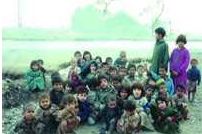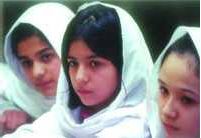Children of War
By Sophie Ali | News & Politics | Published 22 years ago
 One of the phenomenons of war is the inevitability of refugees. Pakistan is now host to more than three million Afghan refugees, many of them children. But who are these children? We often make assumptions about who they are, and what effect the war must have had on them. But do we really know? Can we really understand what is happening in the complex inner life of children that have suffered in ways unimaginable to most of us?
One of the phenomenons of war is the inevitability of refugees. Pakistan is now host to more than three million Afghan refugees, many of them children. But who are these children? We often make assumptions about who they are, and what effect the war must have had on them. But do we really know? Can we really understand what is happening in the complex inner life of children that have suffered in ways unimaginable to most of us?
Does a child of war have the same feelings and sensitivities as other children? Or has he become numb? Is he angry or has he become resigned to his plight? Is life still precious to him? Or has he seen so much death and devastation that he has earned a callousness other children have not? What dreams might he have for himself in his private moments? And what kind of person might he want to grow up to be? These were some of the questions I asked myself as I travelled to Peshawar to meet a large group of refugee children in January.
I was in the process of completing a master’s degree in developmental psychology at Columbia University, with a focus on children in wartime. This trip was intended to get a real, first hand account of the inner feelings of these children for my thesis, but also perhaps to provide the psychological community with information that could be used to develop programmes or interventions designed to help such children.
In theory, this project had been powerful and exciting, but as we approached the school I had arranged to visit, I began to doubt the wisdom in asking intrusive and probing questions. Most of the children at this school were recent refugees either living in Hayatabad itself, or in one of the five nearby camps. The school, run by the Afghan Women’s Council, is clearly trying to accommodate many more children than the small two-storey house can support. Even the extra classrooms, created out of a dank basement and a balcony covered by makeshift canvas roof, hold up to 50 children. Often children have to sit two to a seat or on the floor, and the rooms are so crowded that the desks are jammed right up to the door. Despite this discomfort, the children try never to miss a day. This is because they see this school, not as a fun place to meet their friends, but as virtually their only hope for survival. A child as young as eight will tell you he is determined to educate himself to change his circumstances.
At first glance, these children appeared as carefree and happy as any other group of children, but as I began asking even the most innocuous questions, the dark reality became apparent. I asked a beautiful, surprisingly blonde seven-year-old girl, Atifa, what her favourite colour was. Her face lit up at the question, and then in a small voice she answered, “black.” I have yet to meet a seven-year-old girl who does not say pink, orange, purple or some other vibrant colour.
Initially I was hesitant to probe, fearful of invading their privacy and causing more pain, but to my surprise, the children were very forthcoming. It had seemed apparent to me that children who have experienced so much loss, must suffer from acute depression and anxiety, but I was interested in exactly what this meant, and if it differed from the way in which other disturbed children experience these feelings. At Columbia, I had been part of a research team conducting a study on 11 and 12 year olds. As a result, I had access to some of the best and most widely used psychological measures specifically designed to look at depression and anxiety in children.
 Equipped with these measures, I conducted in-depth interviews with a group of six children talking about some of their most intimate thoughts and feelings.
Equipped with these measures, I conducted in-depth interviews with a group of six children talking about some of their most intimate thoughts and feelings.
Farishta is a warm and communicative 12-year-old. She lived in Mazar-e-Sharif with her family, but after her was father was killed by the Taliban, she, her mother, sister and three brothers travelled to Kabul, and from there to Pakistan.
Madina, also 12, is shy and pretty, but her face is veiled in sadness. She and her family left their home in Wardak three months ago, just after the US bombing campaign began. She now lives in a refugee camp in Peshawar with both her parents, three sisters and two brothers.
Vida has a soft but focused manner. She too is 12 years old. Her parents, two brothers and sister lived in Kabul and only came to Pakistan a month ago. They too live in a refugee camp near Hayatabad.
Parvez has an intelligent face. He is a quiet but confident 12-year-old. He and his family fled their home in Parwn to seek safety in Kabul. However, in Kabul his father was killed by American bombs and he, his mother, seven brothers and two sisters escaped to Pakistan. They got as far as the border by truck, but had to walk the rest of the way across the mountainous Afghan border into Pakistan. It took them 24 hours. He was barefoot.
Samiullah is full of energy. He is eager, and painfully honest. Also only 12, he left his mother behind, and walked all the way from Kabul to Peshawar with a neighbour. He has only been in Pakistan for a month but he has already learned to speak Urdu.
Mustafa is 11 years old and an orphan. After the Taliban murdered his father, his mother ran off with another man. His seven sisters are scattered, but he does not know where any of them are. He is completely alone.
The survey questions from these six children were specifically designed to identify symptoms of depression and anxiety in children this age. They were not culturally specific, focusing mainly on personal perceptions and physiological symptoms. The children answered the questions thoughtfully, coherently, and above all with excruciating honesty.
One of the first questions focused on whether the children felt that all the terrible things that happened to them was somehow their fault. Without exception, all six children said they knew it was not their fault. Parvez said, “It’s not my fault that there is a war in my country, and it is not my fault that my father died, and it is not my fault that I am living in this condition…but,” he continued, with no sign of aggression, “America has ruined my life, who is going to ask them this question?” Samiullah also believed that the horrors he has experienced are not his fault, but added that if they had been, he was not sure he would have the courage to admit it.
Another question on the depression index asked them about feeling loved. None of the six children I spoke to was sure if they were loved by anyone. All of the six children had aches and pains and worried about them all the time. They all suffer from sweaty palms, sickness in their stomachs and had trouble breathing. They worry constantly about facing even more pain and suffering, feel constantly tired and are super sensitive. All classic symptoms of anxiety.
As we headed into a more sensitive area, I asked the children how they felt about themselves. Only two of the six said they liked themselves. The others said they hated themselves. Madina elaborated by explaining that she tries very hard not to hate herself because when she does she feels like “throwing herself under a car.” On hearing this, Mustafa quickly agreed that he felt the same way. These children had not only been candid in their answers, but they had somehow anticipated the most sensitive question on the depression index, the suicide question.
When we conducted this study in America there was an extensive protocol regarding this question. In the unlikely event that a child actually considered killing himself, we had instructions to identify the child immediately. They were to speak with the psychologist heading the study, a leading expert in child risk and resilience. Then the parents would be informed and the child would enter a specific therapy programme. In our study, of the five hundred children surveyed, only one wanted to kill herself. That afternoon in Peshawar, four of the six children I spoke to were suicidal. And there were no therapy programmes for them.
These children are not only struggling to survive in the brutal external world, but in an equally brutal inner world as well. Interestingly however, it seems that paralleling this despair is a strong resilience. Without exception, all six children “believe things will work out” for them. When asked why, they all said that they would make sure it did. They were all aware that they had no other option. They will study hard and work. They will somehow earn enough money, and they were certain their lives would be okay.
After three hours of discussion I had learned a lot about the inner lives of these six children. They were certainly not numb or callous. They were acutely sensitive and very aware of the feelings of others. As we worked our way through a series of painful and difficult questions I noticed their kindness towards each other as each child dealt with their own suffering. They were neither aggressive nor indifferent, and they valued both life and peace with an understanding other children are not even cognisant of. What shone through their despair was their hope and courage. Walking away from them, knowing I could not help them, was one of the hardest things I have ever done.


